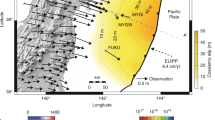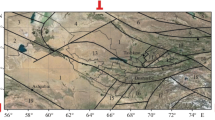Abstract
The laboratory experiments with rock samples show that creep under small strains is transient and can be described by the linear hereditary rheological Andrade model. The flows that recover isostasy (including the postglacial rebound flows) cause the strains in the crust and mantle, which are as low as at most 10–3 and, hence, demonstrate transient creep. The effective viscosity characterizing the transient creep is lower than that at the steady creep and depends on the characteristic time of the considered process. The characteristic time of restoration of isostatic equilibrium (isostatic rebound) after the initial perturbation of the Earth’s surface topography is at most 10 kyr and, therefore, the distribution of the rheological properties along the depth of the mantle and the crust differs from the distribution that corresponds to the slow geological processes. When considering the process of isostatic rebound, the upper crust can be modeled by a thin elastic plate, whereas the underlying crust and the mantle can be modeled by the halfspace with transient creep in which the rheological parameter is inhomogeneous with depth. For this system, the continuum mechanics equations are solved by means of the Fourier and Laplace transforms. The vertical displacements that violate the isostasy propagate from the area of the initial perturbation along the Earth’s surface and can be considered as the mechanism of the present-day vertical movements of the crust. Comparing the obtained results with the observation data allows estimating the Andrade parameter. The use of the Andrade rheological model makes it possible to quantify the relationship between the effective viscosity of the asthenosphere corresponding to the postglacial flows and the seismic Q-factor of this layer.
Similar content being viewed by others
References
Anderson, D., Lithosphere, asthenosphere, and perisphere, Rev. Geophys., 1995, vol. 31, pp. 125–149.
Berckhemer, H., Auer, F., and Drisler, J., High-temperature anelasticity and elasticity of mantle peridotite, Phys. Earth Planet. Inter., 1979, vol. 20, pp. 48–59.
Birger, B.I., Rheology of the Earth and thermoconvective mechanism for sedimentary basins formation, Geophys. J. Int., 1998, vol. 134, pp. 1–12.
Birger, B.I., Excitation of thermoconvective waves in the continental lithosphere, Geophys. J. Int., 2000, vol. 140, pp. 24–36.
Birger, B.I., Attenuation of seismic waves and the universal rheological model of the Earth’s mantle, Izv., Phys. Solid Earth, 2007, vol. 43, no. 8, pp. 635–641.
Birger, B.I., Transient creep and convective instability of the lithosphere, Geophys. J. Int., 2012, vol. 191, pp. 909–922.
Birger, B.I., Temperature-dependent transient creep and dynamics of cratonic lithosphere, Geophys. J. Int., 2013, vol. 195, pp. 695–705.
Birger, B.I., Dinamika litosfery Zemli (Dynamics of the Earth’s Lithosphere), Moscow: Lenand, 2016.
Birger, B.I., Isostatic recovery flows in the lithosphere, Geofiz. Issled., 2017, no. 4, pp. 17–31.
Cathles, L.M., The Viscosity of the Earth’s Mantle, Princeton: Princeton Univ. Press, 1975.
Doetsch, G., Guide to the Applications of the Laplace and ZTransforms, London: Van Nostrand, 1971.
Goetze, C., High temperature rheology of westerly granite, J. Geophys. Res., 1971, vol. 76, pp. 1223–1230.
Goetze, C. and Brace, W.F., Laboratory observations of high-temperature rheology of rocks, Tectonophysics, 1972, vol. 13, pp. 583–600.
Karato, S., Deformation of Earth Materials. An Introduction to the Rheology of Solid Earth, Cambridge: Cambridge Univ. Press, 2008.
Murrell, S.A.F., Rheology of the lithosphere—experimental indications, Tectonophysics, 1976, vol. 36, pp. 5–24.
Murrell, S.A.F. and Chakravarty, S., Some new rheological experiments on igneous rock at temperatures up to 1120°C, Geophys. J. R. Astron. Soc., 1973, vol. 34, pp. 211–250.
Rabotnov, Yu.N., Polzuchest’ elementov konstruktsii (Creep of Construction Elements), Moscow: Nauka, 1966.
Turcotte, D.L. and Schubert, J., Geodynamics, New York: Wiley. 1982.
Weertman, J., Creep laws for the mantle of the Earth, Philos. Trans. R. Soc. London, 1978, vol. A288, pp. 9–26.
Author information
Authors and Affiliations
Corresponding author
Additional information
Original Russian Text © B.I. Birger, 2018, published in Fizika Zemli, 2018, No. 6, pp. 48–58.
Rights and permissions
About this article
Cite this article
Birger, B.I. Andrade Creep at the Isostasy Recovering Flows in the Mantle. Izv., Phys. Solid Earth 54, 849–858 (2018). https://doi.org/10.1134/S1069351318060034
Received:
Accepted:
Published:
Issue Date:
DOI: https://doi.org/10.1134/S1069351318060034




